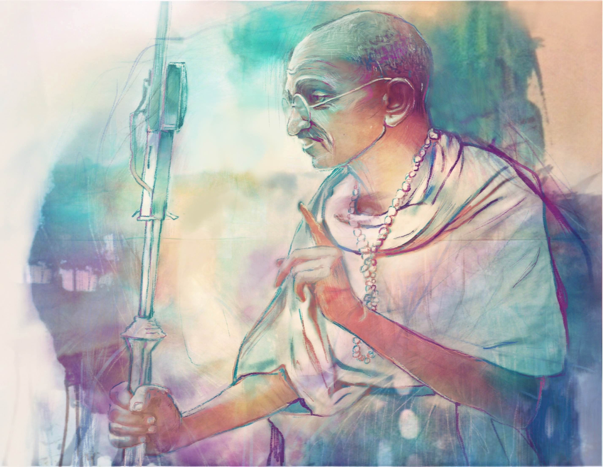
PORTRAIT OF A LEADER
Mohandas Gandhi
The Spiritual Leader
It would be very easy to make the assumption that Spiritual Leaders are passive, tender, and gentle. These leaders are often known for their meekness and humility—and therefore, opponents often underestimate them as being weak or feeble. This assumption would be a gross error in judgment and plays to the advantage of achieving the Spiritual Leader’s quest. Such was the case for Gandhi. His outer frail appearance was the opposite of his inner obstinate nature. Inwardly there was a fierce resolve to hold onto his convictions, and to pursue his intentions with tenacity. Gandhi would prevail in his quest because he was willing to stay the course until his opponents would be forced to acknowledge the “rightness” of his contentions. He demonstrated a courageous spirit with a moral authority that inspired the millions who loved him. He led by casting a vision for a spiritual battle rather than a mere physical one. Gandhi showed patient persistence, where the path to peace was met with victory.

Spiritual Leaders have deep convictions that flow from a commitment to spiritual growth.
The aim of Gandhi’s life was summed up in his own words, “What I want to achieve—what I have been striving and pining to achieve these thirty years—is self-realization, to see god face to face... I live and move and have my being in pursuit of this goal.” Every word, whether silent or spoken, every decision, and every action transpired from his utter commitment to spiritual growth. The trajectory of his life was aimed toward the service of humanity, in hopes that such service would lead to the achievement of his vision. He stated in his autobiography, “If I found myself entirely absorbed in the service of the community, the reason behind it was my desire for self-realization…” His was a life on a quest for, “the Absolute Truth, the Eternal Principle, that is God…” There was no price he would not pay to reach his goal, he further stated, “I have not yet found Him, but I am seeking after Him. I am prepared to sacrifice the things dearest to me in pursuit of this quest. Even if the sacrifice demanded be my very life, I hope I may be prepared to give it.”
Spiritual Leaders reach out to their opponents by peaceful contention.
The British were unprepared for the “peaceful contention” of Gandhi as they were used to winning by brutal force, where they prevailed by “strength and might.” The approach taken by Gandhi was other worldly—one that was foreign and alien to all that the British Empire knew. His quest was to win by the force of truth and love, rather than to triumph by injuring the opposition with violent atrocity. During his leadership, at any moment he had enough influence that he could have called upon millions of Indians who followed, to create an uproar against the tyranny, but this was not his way. Rather, his ardent insistence to those who governed was to confront, by making an appeal to the conscience. Gandhi upheld the value and dignity of all human life—including those who stood vehemently against him with hatred. He felt that all humanity “are children of one and the same Creator…” and that to attack the authors of oppressive systems would be equivalent to attacking oneself, and to bring harm to the whole world.
Spiritual Leaders see the best in others even amidst flaws and deficiencies.
During Gandhi’s time, all Indians were looked upon as flawed and deficient, and even among those of Indian decent, a caste system was in place to honor only those of the upper privileged caste. The people were divided by religious strife, socio-economic levels, educational status, and genealogy—and forging unity amidst such dissension was unfathomable to all. However, Gandhi believed in the best of his people, amidst whatever shortcomings there were. He had this perspective because he understood that amidst weaknesses, strength could be found. For Gandhi, his shyness was his deficiency, but he was able to turn it into his strength. He said, “My shyness has been in reality my shield and buckler. It has allowed me to grow. It has helped me in my discernment of truth.” His shyness facilitated him to turn inward, which helped him to develop an inner-strength, and a fierce inner-resolve. His personal transformation allowed him to see the potential for a spiritual transformation for his people—to no longer accept as truth that they were somehow “less than” because others had defined them this way. By going to the deeper recesses of his soul, he learned to see through a different set of eyes—to discern the truth of his identity, the identity of others, and the identity for India.
Spiritual Leaders express their insights through quiet strength and symbolic action.
Gandhi led by contributing his insights quietly and symbolically. He made statements through symbols, which communicated underlying principles and truths. Whether it be actions or objects used to convey a message, Gandhi communicated to his people and his oppressors through a myriad of powerful symbols: the act of fasting; making salt; a spinning wheel; choosing celibacy; shedding his upper garments; walking barefoot. These were statements with underlying meanings, remembered even decades after they were first used. If each of these symbols were explored, we would find a depth and richness, which would communicate volumes. For our purposes here, let us take a look at the symbolic action known as the “Salt March.” In 1882, the British wrote into law, the “Salt Act”—which gave the British a monopoly on the collection and production of salt. This allowed the government to be the sole provider of salt, and to collect for distribution of salt, and to also levy a tax on the salt—it represented 8.2% of the British tax revenue.
The Indians were forced to purchase salt, even though salt was freely available on the coast (by evaporation of sea water). Salt was used by nearly everyone in India, and the Salt Act significantly hurt the poorest Indians the most. Violation of the Salt Act was a criminal offense. In an act of civil disobedience, Gandhi started to march to the sea. This symbolic action became known as the “Salt March.” With a small handful of followers, their march symbolized their journey towards independence. As the courageous few marched, others joined. By the time Gandhi reached the water’s edge, a group of more than 60,000 followers stood with him. What started out as a mere symbolic action turned into massive civil disobedience—millions of Indians protested the law. Quiet, non-violent defiance was the trademark of their way to freedom. The protests turned into a boycott of all British goods. The British were now finally shaken, and at first, new laws and restrictions were established, but once these tactics rendered ineffectual, the tyranny erupted into the brutal massacre of hundreds of non-violent protesters. With the entire world as the audience, the British were seen as disgraceful, while Gandhi became a symbol of gracefulness. The Salt March marked the beginning of Gandhi’s worldwide fame, recognized for “Soul Power”—he was declared by America’s Time magazine, 1930 “Man of the Year.”
Spiritual Leaders make deliberate choices to engage their followers at the same level.
Gandhi made the statement, “Our ambition was to live the life of the poorest people.” He made his own clothing, and he had a simple diet, which included raw nuts, dates, bananas, lemons and olive oil. Though such acts seem almost foolish and would be easily estimated to be inconsequential, his commitment to live life as being a “part of the people,” and not “above the people” demonstrated for followers a purity for the cause, and authenticity of character. Because he chose to resonate with followers rather than be revered by them, he was able to unite people who were a part of opposing factions. India was composed of many distinctively polarized groups, divided by religion and social class. He united people not by political tactics, or charismatic persuasion—but by being personally present to his people, and by his personal example. He desired for his heart to be the heart of India, and for his every action to be an overflow of his being. Before seeking to lead those who would follow, he sought to understand the essence of his people.
Gandhi desired to be the personal embodiment and voice of a people, and not just a representative or a figurehead to stand up for the people. He took lengthy trips by rail to become more intimate with the conditions of his land. Throughout his travels, he rode on third-class accommodations, which were mainly for the poorest of the land. He deliberately chose to engage the familiar discomfort and dangers faced by travelers who journeyed in overcrowded rail cars, with unspeakable odors, and insanitary conditions, where abuse and violence was not uncommon. Participating in such journeys strengthened his belief that India had to become more. Gandhi understood that every person had intrinsic value and dignity as a human being. And he sought for this truth to be materialized by seeing his people become valued as “citizens” of a country that was yet to become. His pursuit of becoming a nation was far more than just a quest for independence—it was the pursuit to lay hold of a spiritual principle that others had violated repeatedly. Gandhi believed to the core of his being, that those who were set aside as the least, the last, and the lost, were a people who mattered. It was the dream for a people who would find freedom from the spiritual captivity of being devalued, mistreated, and set aside as a lower class.
